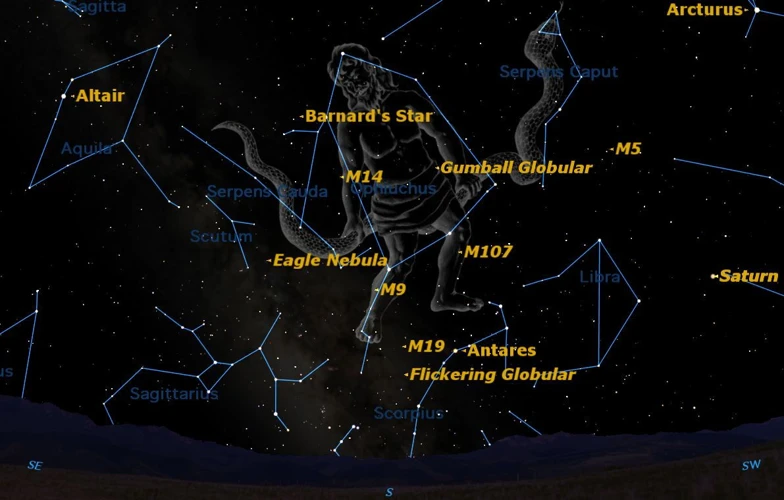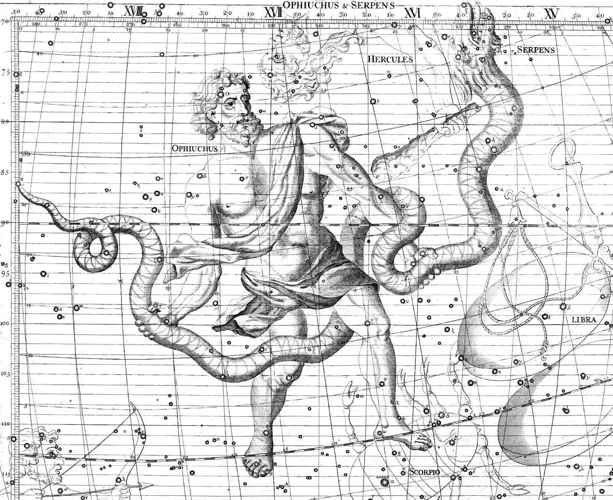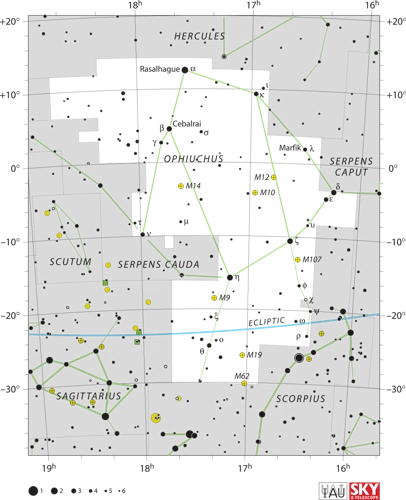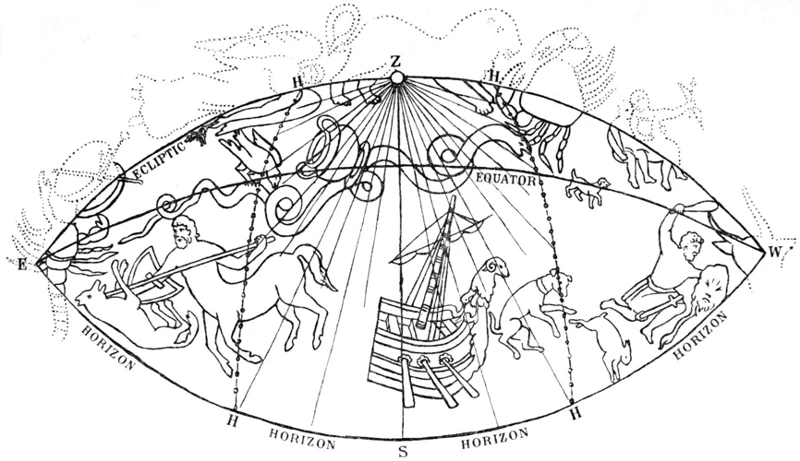Have you ever wondered about the scientific knowledge possessed by ancient astronomers? How did they navigate the vast expanse of the night sky without the aid of modern technology? In this article, we will delve into the world of ancient astronomy, exploring the early observations of the night sky, the birth of constellations, and the ancient civilizations that contributed to our understanding of the stars. We will also dissect some of the most famous ancient constellations, such as Orion the Mighty Hunter and Ursa Major and Ursa Minor, the Great and Little Bear. Join us on a journey back in time as we uncover the secrets of the ancient astronomers and their remarkable scientific knowledge.
Contents
- Ancient Astronomy: An Overview
- The Ancient Constellations
- The Astronomical Knowledge of Ancient Civilizations
- Dissecting the Ancient Constellations
- Conclusion
-
Frequently Asked Questions
- 1. How did ancient astronomers navigate without modern tools?
- 2. Were ancient constellations the same across different civilizations?
- 3. How did ancient astronomers keep track of time?
- 4. Did ancient astronomers have knowledge of planets beyond the ones visible to the naked eye?
- 5. Were ancient constellations purely for navigational purposes?
- 6. How did ancient astronomers record their observations?
- 7. Did ancient astronomers accurately predict celestial events?
- 8. How did ancient civilizations pass down their astronomical knowledge?
- 9. Did ancient astronomers have a concept of the universe’s vastness?
- 10. How did the discoveries of ancient astronomers influence modern astronomy?
- References
-
Frequently Asked Questions
- 1. How did ancient astronomers observe the night sky without modern technology?
- 2. How were constellations created in ancient times?
- 3. Were non-Zodiac constellations important to ancient astronomers?
- 4. What role did constellations play in ancient navigation?
- 5. Did different ancient civilizations interpret constellations differently?
- 6. What were the key astronomical contributions of Mesopotamian civilization?
- 7. How did the Egyptians contribute to ancient astronomy?
- 8. What ancient Greek astronomers are famous for their contributions?
- 9. How did ancient Indian astronomers approach the study of constellations?
- 10. Why were specific mythological stories associated with ancient constellations?
- References
- Read More
Ancient Astronomy: An Overview

Ancient astronomy is a fascinating field of study that provides us with valuable insights into the scientific knowledge of our ancestors. To understand the foundation of ancient astronomy, we must first explore the early observations of the night sky. Ancient civilizations gazed up at the stars, marveling at their beauty and mystery. They noticed patterns and celestial movements, which led to the birth of constellations. These constellations were groups of stars that formed recognizable shapes, allowing ancient astronomers to navigate the sky and keep track of time. The ancient civilizations, such as the Mesopotamians, Egyptians, Greeks, and Indians, each made significant contributions to the field of astronomy, developing their own systems of observation and recording celestial events. Through their rich knowledge and understanding of the stars, ancient astronomers helped shape our understanding of the universe.
1. Early Observations of the Night Sky
Ancient civilizations were keen observers of the night sky, making early observations that laid the foundation for the development of astronomy. These early observations can be grouped into several key aspects:
1. **Celestial Bodies**: Ancient astronomers noticed the movements of celestial bodies such as the sun, moon, planets, and stars. They observed the rising and setting of the sun and moon, tracking their positions to understand the passage of time. Through these observations, they developed calendars and marked important celestial events such as solstices and equinoxes. The movements of the planets, such as Mercury, Venus, Mars, Jupiter, and Saturn, were also observed and documented.
2. **Patterns and Shapes**: Humans have long been captivated by patterns and shapes in the night sky. Ancient astronomers noticed that certain groups of stars formed distinct patterns, which we now call constellations. They identified these patterns and assigned them names and mythological stories. These constellations served as celestial markers, aiding in navigation and storytelling. Famous constellations like Orion, Ursa Major, and Draco were recognized and studied across different civilizations.
3. **Astronomical Phenomena**: Ancient astronomers were astute observers of various astronomical phenomena. They witnessed and recorded meteor showers, comets, eclipses, and other transient celestial events. These observations were often interpreted in cultural and religious contexts, with the belief that these phenomena held significant meaning or messages from the divine.
4. **Instrumentation**: While ancient astronomers lacked sophisticated telescopes, they utilized basic instruments to aid their observations. They developed tools like astrolabes, gnomons, and sundials to measure the position of celestial bodies and track their movements accurately.
These early observations of the night sky laid the groundwork for understanding the celestial realm and formed the basis of ancient astronomical knowledge. Today, we continue to study and build upon the observations made by our ancestors, gaining deeper insights into the vast expanse of the universe. To learn more about the historical and cultural significance of astronomical records and observations, you can explore the link on the ophiuchus-astronomical-records-history.
2. The Birth of Constellations
The birth of constellations marks a significant milestone in the development of ancient astronomy. Ancient civilizations began noticing patterns in the night sky, grouping stars together to form recognizable shapes and figures. These constellations became important tools for navigation, timekeeping, and storytelling. One fascinating example is the constellation Orion, which represents a mighty hunter in various mythologies. Orion is characterized by his distinctive belt of three stars and his raised club or sword. Ancient observers from different cultures saw this pattern and associated it with a heroic figure in their folklore. Similarly, the constellations Ursa Major and Ursa Minor, known as the Great and Little Bear, were named due to their resemblance to these powerful creatures. The birth of constellations allowed ancient astronomers to create a celestial map, helping them navigate both the skies and the seas. These early astronomers developed their own systems of observing and recording celestial events, leaving behind a rich legacy that continues to inspire and captivate us today.
Stellar navigation and timekeeping were crucial aspects of ancient astronomy, allowing civilizations to navigate and keep track of time based on the movements of celestial bodies. Ancient astronomers recognized the patterns of stars and used them as reference points for navigation. They observed how stars rose and set at different times throughout the night, and how their positions changed with the seasons. By understanding these patterns, ancient sailors and travelers could determine their location and navigate across vast distances. In addition to navigation, stars were also used for timekeeping. Ancient astronomers observed that certain stars appeared at specific times of the year, indicating the changing of seasons. They developed calendars based on these observations, dividing the year into months and marking important celestial events such as solstices and equinoxes. The accurate tracking of time allowed ancient civilizations to plan agricultural activities, religious ceremonies, and other societal events. It is truly remarkable how ancient astronomers utilized the celestial bodies to not only navigate the Earth but also create sophisticated timekeeping systems that shaped their civilizations.
The Ancient Constellations

The ancient constellations hold a timeless fascination, as they provide a glimpse into the celestial imagination of our ancestors. These constellations can be divided into two main categories: the zodiac constellations and the non-zodiac constellations. The zodiac constellations, which include familiar names like Aries, Taurus, and Leo, have long been associated with astrology and the positioning of the sun, moon, and planets. They played a crucial role in ancient civilizations’ beliefs and interpretations of celestial events. On the other hand, the non-zodiac constellations feature a wide variety of mythical creatures, heroes, and objects. Orion, the mighty hunter, holds a prominent place in the night sky, while Ursa Major and Ursa Minor form the Great and Little Bear. Draco, the serpent-like dragon, and Pegasus, the winged horse, also capture our imagination. Each of these constellations carries its own unique stories and symbolism, inviting us to explore the deeper connections between the stars and humanity’s rich cultural heritage.
1. The Zodiac Constellations
The Zodiac Constellations have long held a prominent place in ancient astronomy and continue to fascinate people today. These constellations form a band around the celestial sphere and are divided into twelve equal parts of the zodiacal circle. The zodiac constellations align with the ecliptic, the path that the Sun appears to take across the sky throughout the year. Each of these constellations holds great significance in astrology and has been used for thousands of years to determine astrological signs. The twelve zodiac constellations include Aries, Taurus, Gemini, Cancer, Leo, Virgo, Libra, Scorpio, Sagittarius, Capricorn, Aquarius, and Pisces. These constellations not only served as a way to track the Sun’s position in the sky but were also associated with different personality traits and characteristics. For example, Leo the Lion is often associated with leadership, confidence, and strength. It’s important to note that the zodiac constellations have a fixed relationship with the Sun, and due to the precession of the Earth’s axis, their alignment has gradually shifted over time. This shift led to the discovery of the thirteenth constellation, Ophiuchus, which was historically not included in the zodiac. To learn more about Ophiuchus and its impact on astrological interpretations, refer to our article “Ophiuchus: Astronomical Records and History”. The zodiac constellations hold a rich history and continue to be a source of intrigue and exploration in the world of ancient astronomy.
2. The Non-Zodiac Constellations
The non-zodiac constellations are a diverse group of star formations that do not fall within the “path” of the Sun, known as the ecliptic. While the zodiac constellations play a significant role in astrology, the non-zodiac constellations have their own fascinating stories and mythologies. These constellations often depict mythical creatures, heroes, and objects from ancient mythology. One prominent non-zodiac constellation is Orion, the mighty hunter, known for his belt of three stars and his impressive constellation shape. Another well-known non-zodiac constellation is Ursa Major and Ursa Minor, commonly known as the Great and Little Bear. Ursa Major features the iconic Big Dipper, which is widely recognized as a navigational tool. Draco, the dragon, is another captivating non-zodiac constellation, often associated with the mythological creature from ancient legends. Pegasus, the winged horse, and Andromeda, the princess chained to a rock, are two more intriguing non-zodiac constellations, each with its own captivating mythological backstory. Exploring the non-zodiac constellations allows us to appreciate the rich tapestry of ancient myths and culture that intertwines with the science of astronomy.
The Astronomical Knowledge of Ancient Civilizations

The ancient civilizations of Mesopotamia, Egypt, Greece, and India possessed remarkable astronomical knowledge that laid the foundation for our modern understanding of the cosmos. The Mesopotamians, for instance, meticulously recorded astronomical observations on clay tablets, enabling them to predict celestial events such as eclipses and planetary movements. The Egyptians, on the other hand, used astronomical observations to develop their calendar and align their structures with celestial bodies. In Greece, renowned astronomers like Ptolemy and Hipparchus made groundbreaking discoveries, including the Earth’s rotation and the calculation of the Earth’s circumference. Indian astronomers, including Aryabhata and Brahmagupta, made significant contributions to trigonometry and accurately calculated celestial coordinates. These ancient civilizations not only possessed a deep understanding of celestial bodies but also wove them into their cultural and religious beliefs, as seen in fascinating legends of deities like Shiva, whose cosmic dance symbolizes the cyclic nature of the universe. Explore the depths of their astronomical knowledge and unravel the enigmatic connection between ancient astronomy and mythology.
1. Mesopotamian Astronomy
Mesopotamian astronomy holds a prominent place in the annals of ancient scientific knowledge. The Mesopotamians, who inhabited the region known as Mesopotamia, which corresponds to present-day Iraq, were avid observers of the night sky. They believed that celestial events held great significance and were interconnected with earthly affairs. The Mesopotamians meticulously documented their observations and developed a sophisticated system of astronomical records. They created extensive astronomical catalogs, known as star catalogues, which listed the positions, magnitudes, and other characteristics of celestial objects. These catalogs were crucial for predicting astronomical phenomena, such as eclipses and the motions of planets. The Mesopotamians also made significant progress in mathematical astronomy, developing mathematical models to calculate celestial movements accurately. Their knowledge and understanding of celestial events enabled them to establish a calendar system that aligned with the lunar phases and solar year. They expressed their astronomical beliefs and interpretations through various religious texts and myths. For instance, the Mesopotamian epic “Enuma Elish” describes the battle between the gods Marduk and Tiamat using cosmic imagery, representing the celestial order and chaos. The Mesopotamians’ achievements in astronomy laid the foundation for future civilizations and made a lasting impact on our understanding of the cosmos.
2. Egyptian Astronomy
Egyptian astronomy was deeply rooted in the culture and religion of ancient Egypt. The Egyptians believed that the stars and celestial bodies were connected to their gods and played a crucial role in the afterlife. They observed the night sky to track the movements of heavenly bodies, particularly the sun, moon, and stars. One of their most important astronomical structures was the Giza Plateau, where they built the famous pyramids and aligned them with the stars. The pyramids’ narrow passages were aligned with certain celestial bodies, allowing the Egyptians to track the movement of stars throughout the year. The Egyptians also developed a calendar based on the observation of astronomical events, particularly the annual flooding of the Nile River, which served as the foundation for their agricultural practices. Their understanding of astronomical phenomena and the cyclical nature of celestial events helped them create a stable and prosperous civilization. The complex relationship between Egyptian culture, religion, and astronomy demonstrates the profound impact the stars had on their society.
3. Greek Astronomy
Greek astronomy played an instrumental role in the development of ancient scientific knowledge. The Greeks believed that the Earth was at the center of the universe, with all celestial bodies revolving around it in perfect circles. This geocentric model was put forth by philosophers such as Aristotle and Ptolemy. One of the most influential astronomers of ancient Greece was Hipparchus, who is often referred to as the “father of trigonometry.” He made significant contributions to the field by developing a method for calculating the size and distance of celestial bodies. Another notable Greek astronomer was Claudius Ptolemy, who compiled a comprehensive treatise called the “Almagest,” which contained a wealth of astronomical knowledge. Ptolemy’s work became the standard authority on astronomy in the Western world for over a thousand years. Greek astronomers also contributed to the understanding of celestial mechanics, studying planetary motions and developing theories to explain the irregularities in their paths. Their observations and calculations paved the way for future advancements in astronomy and had a profound influence on subsequent civilizations. The legacy of Greek astronomy continues to be celebrated and studied in the modern world, highlighting the enduring impact of their scientific pursuits.
4. Indian Astronomy
Indian astronomy holds a significant place in the history of ancient scientific knowledge. The early astronomers of India made remarkable contributions to the field, developing intricate systems for observing and understanding celestial phenomena. One of the most notable works in Indian astronomy is the Surya Siddhanta, a treatise dated back to the 5th century. This text provides detailed calculations for determining various astronomical parameters, such as the length of a year, the movements of the planets, and the occurrence of eclipses. Indian astronomers were also pioneers in the concept of zero and the decimal numeral system, which revolutionized mathematical calculations and made intricate astronomical calculations possible. Additionally, ancient Indian astronomy was closely intertwined with astrology, and the positions of celestial bodies were believed to have a significant influence on human lives. The study of the stars and the interpretation of astrological charts have been an integral part of Indian culture for centuries. To this day, astrology plays a role in daily life and decision-making for many individuals in India. Understanding the remarkable achievements of ancient Indian astronomers provides us with a glimpse into their rich cosmological and astrological traditions.
For more fascinating information about Indian legends and mythology, check out our article on “Fascinating Legends of Shiva”
Dissecting the Ancient Constellations

One of the most captivating aspects of ancient astronomy is the study of the ancient constellations. These celestial formations have fascinated humans for centuries, and by dissecting their origins and meanings, we can gain deeper insights into the scientific and cultural knowledge of the past. Orion, the mighty hunter, is a constellation that has captured the imagination of countless civilizations. Ursa Major and Ursa Minor, also known as the Great and Little Bear, have their own fascinating legends and stories associated with them. Draco, the dragon, with its sinuous shape winding across the sky, holds a mystical allure. Pegasus, the winged horse, embodies the ethereal and mythical. And Andromeda, the princess chained to the rock, adds a touch of drama to the celestial tapestry. By exploring these ancient constellations, we can unlock a glimpse into the cosmic storytelling and reverence that ancient civilizations held for the stars above. To dive deeper into the mythology and symbolism behind these constellations, check out the fascinating legends of Shiva.
1. Orion: The Mighty Hunter
Orion, known as the Mighty Hunter in ancient mythology, is one of the most recognizable constellations in the night sky. It is located on the celestial equator and can be seen from both the northern and southern hemispheres. The constellation is named after the Greek hunter Orion, who was renowned for his incredible strength and hunting prowess. The stars that form Orion’s belt are particularly prominent and are easily identifiable. These three stars, Alnitak, Alnilam, and Mintaka, create a distinctive line that stretches across the sky. Orion’s belt is surrounded by other notable stars, including Betelgeuse, a red supergiant, and Rigel, a blue supergiant. According to Greek mythology, Orion was placed among the stars after his death, forever immortalized as a constellation. The mythology surrounding Orion is captivating, and his presence in the night sky has fascinated astronomers and stargazers throughout history. Learn more about the fascinating legends and stories associated with constellations like Orion, including the power of the Moon and Neptune and their empathic compatibility or the intriguing legends of the Hindu deity Shiva.
2. Ursa Major and Ursa Minor: The Great and Little Bear
Ursa Major and Ursa Minor, known as the Great and Little Bear respectively, are two of the most well-known and easily recognizable constellations in the night sky. Ursa Major, also referred to as the Big Dipper, is a group of seven bright stars that form the shape of a ladle or a saucepan. These stars have been a navigational tool for centuries, helping sailors and travelers find their direction, especially the North Star, which is a part of Ursa Minor. Ursa Minor, also known as the Little Dipper, contains the North Star, Polaris, which is a significant celestial marker for determining direction on Earth. The legend behind these constellations varies across different cultures. In Greek mythology, Ursa Major and Ursa Minor represent two nymphs, Callisto and her son Arcas, who were transformed into bears by the god Zeus. This transformation was a punishment due to Callisto’s involvement with Zeus. However, in Hindu mythology, Ursa Major and Ursa Minor are associated with the god Shiva and are considered a symbol of strength and protection. The fascinating legends surrounding these constellations add to their allure and interest for stargazers and mythological enthusiasts alike. To learn more about fascinating legends, you can explore the legends of Shiva, which encompass a rich tapestry of mythical tales. So next time you gaze at the night sky, remember the story of Ursa Major and Ursa Minor and appreciate the scientific knowledge and cultural significance embedded within these celestial wonders.
3. Draco: The Dragon
Draco, also known as the Dragon, is a prominent constellation in the northern sky. It is one of the largest constellations, stretching across 1083 square degrees. Its Greek name “Draco” means “dragon,” and it is said to represent Ladon, a dragon from Greek mythology that guarded the golden apples in the Garden of the Hesperides. In ancient astronomy, Draco was often depicted as a serpent or dragon with a long body winding through the sky. The constellation is home to several notable stars, including Thuban, which was once the North Star around 2700 BC due to the precession of the Earth’s axis. The head of Draco is marked by the star Eltanin, which translates to “the dragon’s eye.”
Draco is also linked to a fascinating astronomical event known as the Draconid meteor shower. These meteors appear to radiate from the constellation’s direction when the Earth passes through the dust left behind by the comet 21P/Giacobini-Zinner. The Draconids are known for their occasional outbursts, producing a larger number of meteors than usual. Witnessing this celestial phenomenon can be a mesmerizing experience for stargazers and astronomy enthusiasts.
In mythology and folklore, dragons symbolize power, strength, and often guard hidden treasures. The concept of dragons can be found in various cultures and mythologies worldwide, each with its own interpretation and significance. The mention of dragons in ancient astronomical observations reflects the deep-rooted connections between astronomy and mythology in ancient civilizations.
Exploring the ancient constellation of Draco allows us to appreciate the ingenuity of ancient astronomers in identifying and naming these celestial formations. Their intricate observations and interpretations of the night sky continue to captivate our imagination and remind us of the wonders that lie beyond our planet.
4. Pegasus: The Winged Horse
Pegasus, known as the Winged Horse, is one of the most recognizable constellations in the night sky. According to Greek mythology, Pegasus was a divine creature, born from the blood of the decapitated Medusa. It was said to have been tamed and ridden by the hero Bellerophon. In the constellation Pegasus, four main stars form the shape of a square, representing the horse’s body. One of these stars, Alpha Pegasi, also known as Markab, represents Pegasus’ front hooves. Pegasus is notable for its distinct “Great Square” asterism, which helps skywatchers locate other constellations in the vicinity.
Pegasus is also associated with several fascinating celestial objects, including the famous globular cluster M15. Located within the constellation’s body, M15 is a dense ball of hundreds of thousands of stars. Additionally, the Pegasus constellation is home to several galaxies, such as the well-known spiral galaxy NGC 7331. These galaxies provide astronomers with valuable opportunities to study distant celestial objects and gain insights into the formation and evolution of galaxies.
The mythology and symbolism surrounding Pegasus have captured the imagination of countless cultures throughout history. Its representation as a winged horse has been depicted in numerous works of art and literature, symbolizing freedom, grace, and the transcendence of earthly limitations. Today, Pegasus continues to inspire astronomers and stargazers alike as they marvel at its beauty and the mysteries of the universe it represents.
5. Andromeda: The Princess Chained to the Rock
In ancient mythology and astronomy, Andromeda is a constellation associated with the Greek myth of the princess Andromeda, who was said to be chained to a rock as a sacrifice to a sea monster. Within the Andromeda constellation, there are several notable stars and celestial objects. One of the most prominent features is the Andromeda Galaxy, also known as Messier 31 or M31. It is a spiral galaxy located approximately 2.537 million light-years away from Earth and is the closest major galaxy to our own Milky Way. The Andromeda Galaxy is visible to the naked eye and is a popular target for amateur astronomers. It is a vast cosmic structure composed of billions of stars, gas, and dust. The Andromeda constellation also contains several other deep sky objects, such as the Andromeda Nebula, also known as the Great Andromeda Nebula or Messier 42, a bright emission nebula located within the region. This nebula is a site of active star formation and is easily visible in the night sky. The Andromeda constellation is a captivating and significant part of ancient astronomy, connecting us to the mythological stories and celestial wonders of the past. (Source: Wikipedia)
Conclusion

In conclusion, the scientific knowledge of ancient astronomers and their understanding of the night sky were truly remarkable. Through their careful observations and astute deductions, they were able to decipher the patterns, movements, and celestial events that shaped their world. The birth of constellations allowed for stellar navigation and timekeeping, providing a practical tool for ancient civilizations. The ancient constellations, both zodiac and non-zodiac, still captivate our imagination today, serving as a testament to the enduring legacy of ancient astronomers. Furthermore, the astronomical knowledge of civilizations like the Mesopotamians, Egyptians, Greeks, and Indians laid the foundations for modern astronomy and influenced our understanding of the cosmos. By dissecting the ancient constellations such as Orion, Ursa Major and Ursa Minor, Draco, Pegasus, and Andromeda, we gain a deeper appreciation for the cultural significance and scientific achievements of our ancestors. The knowledge passed down by ancient astronomers has shaped our understanding of the universe and continues to inspire future generations of stargazers and scientists. So, let us gaze up at the night sky with wonder, embracing the wisdom of the ancient astronomers in our ongoing exploration of the cosmos.
Frequently Asked Questions

Ancient astronomers navigated the night sky using simple observational techniques. They observed the movements of the stars, planets, and other celestial bodies, noting their patterns and positions. This allowed them to create charts and maps that aided in navigation.
2. Were ancient constellations the same across different civilizations?
No, ancient constellations varied across different civilizations. While some constellations, such as Orion and Ursa Major, can be found in multiple ancient cultures, there were also unique constellations specific to each civilization. Cultural beliefs and mythologies influenced the choice and naming of constellations.
3. How did ancient astronomers keep track of time?
Ancient astronomers used the relative motion of celestial bodies, such as the Sun, Moon, and stars, to keep track of time. They developed different methods, such as sundials and star charts, to measure the passage of time and align their calendars with astronomical events.
4. Did ancient astronomers have knowledge of planets beyond the ones visible to the naked eye?
Ancient astronomers had limited knowledge of planets beyond those visible to the naked eye. They were aware of the five classical planets – Mercury, Venus, Mars, Jupiter, and Saturn – and attributed them with astrological significance. However, they did not have telescopic technology to discover other planets.
No, ancient constellations served multiple purposes. While some constellations were used for navigational purposes and helped ancient sailors and travelers find their way, many constellations were also linked to mythological stories and religious beliefs. They were used to convey cultural narratives and convey important celestial events.
6. How did ancient astronomers record their observations?
Ancient astronomers recorded their observations using various methods. They inscribed their findings on clay tablets, papyrus scrolls, and stone monuments. These records often included diagrams and descriptions of celestial phenomena, allowing them to study and track celestial events over time.
7. Did ancient astronomers accurately predict celestial events?
Ancient astronomers had a remarkable ability to predict certain celestial events. They could accurately predict the movements of the Sun, phases of the Moon, and eclipses. Their knowledge of the celestial cycles and patterns allowed them to plan agricultural activities, religious ceremonies, and even navigate the open seas.
8. How did ancient civilizations pass down their astronomical knowledge?
Astronomical knowledge was passed down through generations in ancient civilizations through oral traditions and teachings. Expert astronomers and priests within the society would train apprentices, passing on their knowledge and observations. Important astronomical findings were often recorded and shared among scholars.
9. Did ancient astronomers have a concept of the universe’s vastness?
Ancient astronomers had some understanding of the vastness of the universe, although their concept of its size and scope was limited. They believed that the Earth was at the center and that the celestial bodies orbited around it in perfect circles. However, they recognized the vast distances between stars and planets.
10. How did the discoveries of ancient astronomers influence modern astronomy?
The discoveries and knowledge of ancient astronomers laid the foundation for modern astronomy. Many of their observational techniques, such as mapping the sky and documenting celestial events, are still used today. Their knowledge also influenced the development of the scientific method and inspired subsequent astronomers to study the universe with a critical mindset.
References
Frequently Asked Questions

1. How did ancient astronomers observe the night sky without modern technology?
Ancient astronomers relied on their naked eyes for observations, free from the light pollution that hinders our visibility today. They studied the stars, planets, and other celestial bodies using their keen vision and some basic tools like handheld devices to measure angles.
2. How were constellations created in ancient times?
Ancient civilizations connected the dots between stars to form patterns that resembled objects or creatures. These patterns were then given names and associated with myths, legends, and cultural significance, creating the constellations we know today.
3. Were non-Zodiac constellations important to ancient astronomers?
Absolutely! Non-Zodiac constellations played a significant role in ancient astronomy, serving as navigational aids, timekeeping tools, and celestial markers for various cultural events and agricultural practices.
Constellations provided ancient sailors and travelers with crucial navigational markers. By observing the positions of specific constellations relative to the horizon, ancient astronomers could determine their location and navigate across vast distances.
5. Did different ancient civilizations interpret constellations differently?
Yes, different ancient civilizations had their own unique interpretations and names for constellations. While some constellations were recognized across various cultures, their mythological associations and significance often varied among civilizations.
6. What were the key astronomical contributions of Mesopotamian civilization?
Mesopotamian astronomers made significant contributions to ancient astronomy. They developed complex mathematical techniques to predict celestial events, created detailed star catalogs, and even influenced later civilizations in developing their own astronomical systems.
7. How did the Egyptians contribute to ancient astronomy?
The Egyptians had a deep connection with the stars, using them for religious purposes and relying on astronomical knowledge for practical purposes like agriculture. They particularly focused on the movements of the star Sirius and its connection to the annual flood of the Nile River.
8. What ancient Greek astronomers are famous for their contributions?
Ancient Greek astronomers like Hipparchus and Ptolemy made significant contributions to astronomy. Hipparchus created the first comprehensive star catalog, while Ptolemy’s geocentric model of the universe dominated Western astronomical thought for centuries.
9. How did ancient Indian astronomers approach the study of constellations?
Ancient Indian astronomers had a deep connection with the cosmos and divided the sky into 27 lunar mansions or nakshatras, which were intricately linked to seasons, agriculture, and astrology. They also developed advanced mathematical techniques to calculate celestial motion.
10. Why were specific mythological stories associated with ancient constellations?
Ancient cultures used mythological stories to pass down knowledge and provide a cultural context for constellations. These stories added depth and meaning to the celestial patterns, helping people remember and understand the constellations for generations to come.
References
- Ancient Greek Astronomy and Cosmology | Modeling the …
- The Remarkable Science of Ancient Astronomy
- Science in the ancient world







